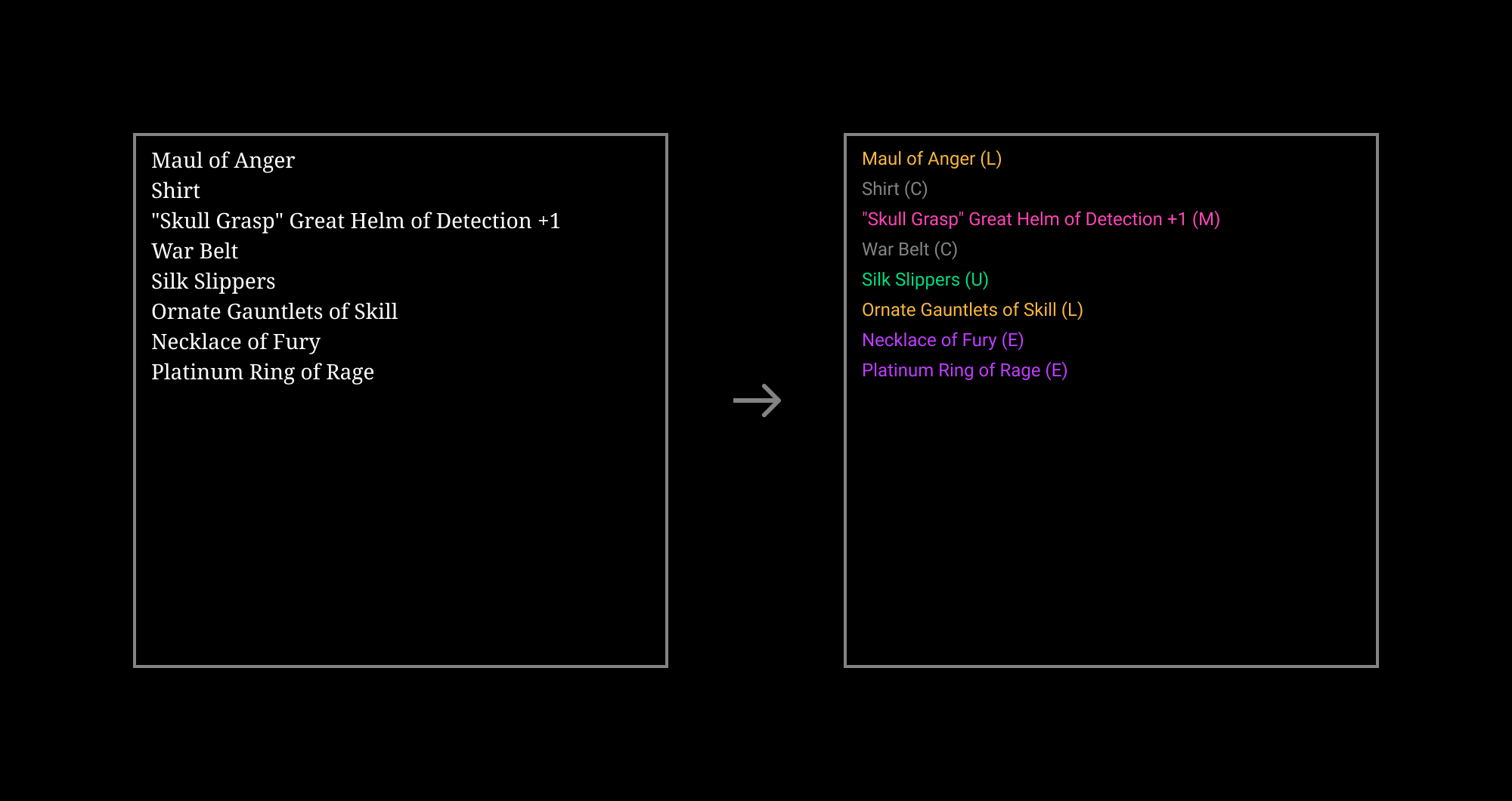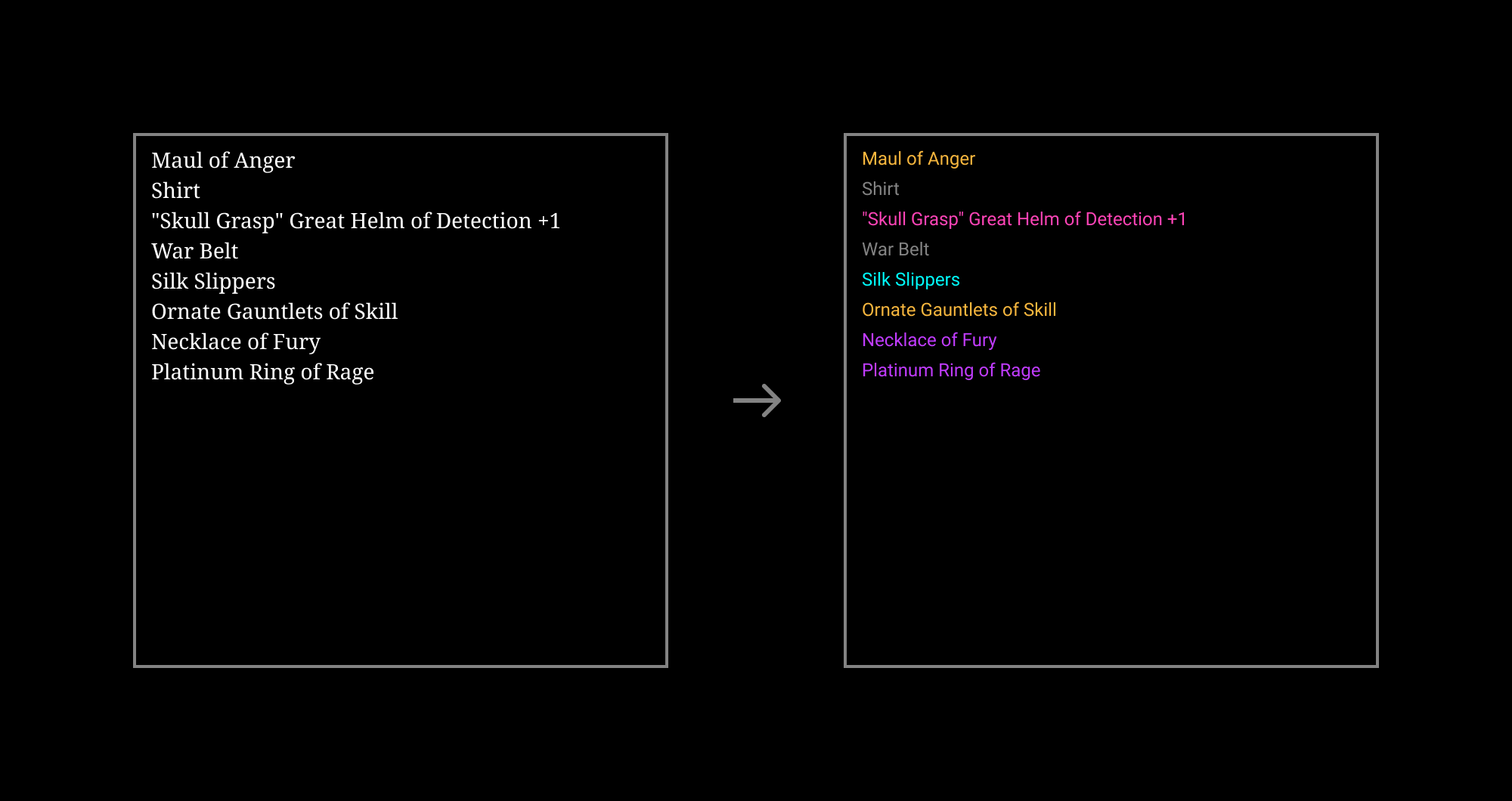Rarity levels for Loot.
How are the rarity levels determined?
The rarity level of any given item is deducted from its number of occurrences in the total number of Loot items.
Installation
npm i --save loot-rarity # npm
yarn add loot-rarity # yarn
pnpm add loot-rarity # pnpmAPI
Types
// RarityLevel goes from 1 (common) to 6 (mythic). See table above for more info.
type RarityLevel = 1 | 2 | 3 | 4 | 5 | 6;
// ColorFn allows to override a color in different places.
type ColorFn = (colorParameters: {
level: RarityLevel; // the rarity level
color: string; // the base color you can override
itemName?: string; // in certain cases the item name will be present
}) => string | void | null; // return a string to override the coloritemRarity()
function itemRarity(itemName: string): RarityLevel;This function returns the rarity level of an item, given its name.
Example:
let rarity = itemRarity('"Golem Roar" Studded Leather Belt of Fury');
console.log(rarity); // 6lootRarity()
function lootRarity(items: string): RarityLevel;This function returns the rarity level of a Loot from the 8 items it contains.
Example:
let items = [
"Warhammer of the Fox",
"Studded Leather Armor",
"Demon Crown",
"Sash",
"Studded Leather Boots of Power",
"Silk Gloves",
"Necklace of Power",
"Silver Ring",
];
let rarity = lootRarity(items);
console.log(rarity); // 3rarityColor()
function rarityColor(
itemOrRarityLevel: string | RarityLevel,
options?: { colorFn: ColorFn }
): string;This function returns the color of a rarity level, given an item name or a rarity level.
Example:
let color = rarityColor("Ornate Belt of Perfection");
console.log(color); // "#c13cff"rarityDescription()
function rarityDescription(itemOrRarityLevel: string | RarityLevel): string;This function returns the description of a rarity level, given an item name or a rarity level.
Example:
let levelA = rarityDescription(1);
let levelB = rarityDescription("Studded Leather Boots of Rage");
console.log(levelA); // "Common"
console.log(levelB); // "Legendary"rarityImage()
function rarityImage(
imageOrItems: string | string[],
options?: {
colorFn?: ColorFn;
displayItemLevels?: Boolean;
displayLootLevel?: Boolean;
imageFormat: "data-uri" | "svg";
}
): Promise<string>;This function generates an image with added rarity levels.
It accepts any of the following:
- SVG source of a Loot image.
- An array of Loot items.
- Data URI representing a Loot image.
- Data URI representing a Loot metadata (as returned by the
tokenURI()method of the Loot contract). - HTTP URL pointing to a Loot image.
Options:
-
colorFnallows to override the color of a particular item. -
displayItemLevelsallows to add levels to the items list. -
displayLootLevelallows to display the Loot level badge. -
imageFormatcontrols the output: data URI ("data-uri") (default) or SVG source ("svg").
Example with React, use-nft to load the image, and swr to handle the async function:
import { rarityImage } from "loot-rarity";
import { useNft } from "use-nft";
import useSWR from "swr";
function Loot({ tokenId }) {
const { nft } = useNft(LOOT, id);
const { data: image } = useSWR(nft?.image, rarityImage);
return image ? <img src={image} /> : <div>Loading…</div>;
}The resulting images could look like this:
Default
let image = await rarityImage(image);With the rarity levels displayed
let rarified = await rarityImage(image, { displayItemLevels: true });With custom colors
let rarified = await rarityImage(image, {
colorFn: ({ itemName }) => itemName?.includes("Slippers") && "cyan",
});With the Loot level
let rarified = await rarityImage(image, { displayLootLevel: true });rarityImageFromItems()
function rarityImageFromItems(
items: string[],
options: {
colorFn?: ColorFn;
displayItemLevels?: Boolean;
displayLootLevel?: Boolean;
imageFormat: "data-uri" | "svg";
}
): string;This function is similar to rarityImage, except it only accepts an array of items. It is useful when you already have a list of items, because it returns a string directly (while rarityImage() returns a Promise resolving to a string).
Options:
-
colorFnallows to override the color of a particular item. -
displayItemLevelsallows to add levels to the items list. -
displayLootLevelallows to display the Loot level badge. -
imageFormatcontrols the output: data URI ("data-uri") (default) or SVG source ("svg").
Example:
import { rarityImageFromItems } from "loot-rarity";
const bag = [
"Grimoire",
'"Woe Bite" Ornate Chestplate of the Fox +1',
"Silk Hood",
"Heavy Belt of Fury",
"Shoes",
"Silk Gloves",
'"Rune Glow" Amulet of Rage',
"Silver Ring",
];
document.body.innerHTML = `
<img src=${rarityImageFromItems(bag)} />
`;Demo app
Have a look at the demo app to see how it works.
You can also run it from this repository (see demo/):
# Install pnpm if needed
npm i -g pnpm
# Build loot-rarity
pnpm i
pnpm build
# Run the demo app
cd demo
pnpm i
pnpm devThanks
- @scotato for github.com/scotato/inventory, loot-rarity was heavily inspired by it.
- @Anish-Agnihotri for the data he extracted from Loot and that loot-rarity is using.
License
MIT





